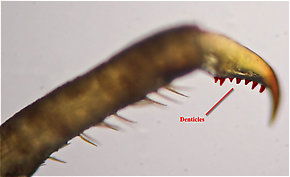Blog & Latest Updates
Fly Fishing Articles
Insects by Common Name


Insect Order Ephemeroptera (Mayflies)
Taxonomic Navigation -?-
Kingdom
Animalia (Animals)
» Phylum
Arthropoda (Arthropods)
» Class
Insecta (Insects)
» Order Ephemeroptera (Mayflies)
8 families aren't included.
Common Name
| Match | Common Name |
| Mayflies |
This is page 52 of specimens of Ephemeroptera. Visit the main Ephemeroptera page for:
- The behavior and habitat of Ephemeroptera.
- 67 underwater pictures of Ephemeroptera.
Pictures of 828 Mayfly Specimens:
Paraleptophlebia bicornuta (Mahogany Dun) Mayfly Nymph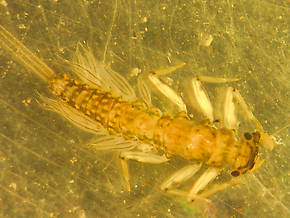 View 1 PicturesThis species is interesting because it is common in lakes as well as streams. It is one of the last species of the year to emerge in western Montana. Adults have been collected as late as October 15 weather permitting.
View 1 PicturesThis species is interesting because it is common in lakes as well as streams. It is one of the last species of the year to emerge in western Montana. Adults have been collected as late as October 15 weather permitting.
 View 1 PicturesThis species is interesting because it is common in lakes as well as streams. It is one of the last species of the year to emerge in western Montana. Adults have been collected as late as October 15 weather permitting.
View 1 PicturesThis species is interesting because it is common in lakes as well as streams. It is one of the last species of the year to emerge in western Montana. Adults have been collected as late as October 15 weather permitting.Collected July 31, 2007 from Flathead Lake in Montana
Added to Troutnut.com by Bnewell on June 26, 2011
Added to Troutnut.com by Bnewell on June 26, 2011
Drunella flavilinea (Flav) Mayfly Spinner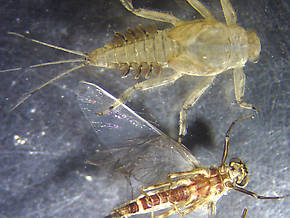 View 1 Pictures
View 1 Pictures
 View 1 Pictures
View 1 PicturesCollected July 31, 2010 from the Flathead River-lower in Montana
Added to Troutnut.com by Bnewell on June 29, 2011
Added to Troutnut.com by Bnewell on June 29, 2011
Male Rhithrogena hageni (Western Black Quill) Mayfly Spinner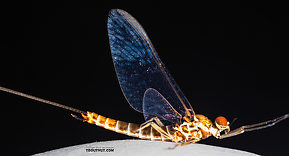 View 14 PicturesAlthough I could not find the preserved specimen to examine under my good new microscope, I'm tentatively calling it one Rhithrogena hageni, based on apparent similarity to this specimen, which I was able to positively ID.
View 14 PicturesAlthough I could not find the preserved specimen to examine under my good new microscope, I'm tentatively calling it one Rhithrogena hageni, based on apparent similarity to this specimen, which I was able to positively ID.
The relative angle of the penes (Penes: The paired genital structures of most male insects, which vary widely in form and are one of the main characteristics used for species identification.) is a bit shallower in this specimen, but I photographed another specimen from the same collecting trip (and I think even the same swarm, although I don't recall for sure) as the other one, and it had the shallower angle seen on this specimen. I'm guessing it's just variation within the species.
 View 14 PicturesAlthough I could not find the preserved specimen to examine under my good new microscope, I'm tentatively calling it one Rhithrogena hageni, based on apparent similarity to this specimen, which I was able to positively ID.
View 14 PicturesAlthough I could not find the preserved specimen to examine under my good new microscope, I'm tentatively calling it one Rhithrogena hageni, based on apparent similarity to this specimen, which I was able to positively ID. The relative angle of the penes (Penes: The paired genital structures of most male insects, which vary widely in form and are one of the main characteristics used for species identification.) is a bit shallower in this specimen, but I photographed another specimen from the same collecting trip (and I think even the same swarm, although I don't recall for sure) as the other one, and it had the shallower angle seen on this specimen. I'm guessing it's just variation within the species.
Collected July 8, 2019 from the Ruby River in Montana
Added to Troutnut.com by Troutnut on July 18, 2019
Added to Troutnut.com by Troutnut on July 18, 2019
Female Ephemerella tibialis (Little Western Dark Hendrickson) Mayfly Dun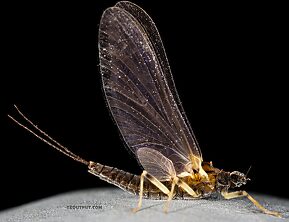 View 6 PicturesI'm fairly confident calling this dun Ephemerella tibialis because it emerged from one of several similar nymphs in my bucket, which I was able to ID with quite a bit of certainty. However, it looks very different from the other duns I currently have listed, which makes me rethink their IDs.
View 6 PicturesI'm fairly confident calling this dun Ephemerella tibialis because it emerged from one of several similar nymphs in my bucket, which I was able to ID with quite a bit of certainty. However, it looks very different from the other duns I currently have listed, which makes me rethink their IDs.
 View 6 PicturesI'm fairly confident calling this dun Ephemerella tibialis because it emerged from one of several similar nymphs in my bucket, which I was able to ID with quite a bit of certainty. However, it looks very different from the other duns I currently have listed, which makes me rethink their IDs.
View 6 PicturesI'm fairly confident calling this dun Ephemerella tibialis because it emerged from one of several similar nymphs in my bucket, which I was able to ID with quite a bit of certainty. However, it looks very different from the other duns I currently have listed, which makes me rethink their IDs.Collected August 3, 2020 from the East Fork Big Lost River in Idaho
Added to Troutnut.com by Troutnut on August 18, 2020
Added to Troutnut.com by Troutnut on August 18, 2020
Male Eurylophella (Chocolate Duns) Mayfly Spinner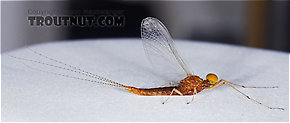 View 12 Pictures
View 12 Pictures
 View 12 Pictures
View 12 PicturesCollected June 4, 2005 from the Teal River in Wisconsin
Added to Troutnut.com by Troutnut on May 24, 2006
Added to Troutnut.com by Troutnut on May 24, 2006
Female Siphlonurus alternatus (Gray Drake) Mayfly Spinner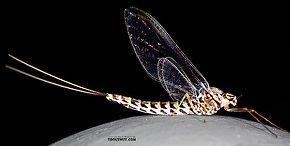 View 7 PicturesI'm tentatively classifying this one as Siphlonurus alternatus, because it seems to fit that species best in the old keys in Needham's Biology of Mayflies, but I'm hesitant because I can't find documentation that southwest Montana or the surrounding area is within the species' range, although they are widely distributed throughout eastern North American and western Canada.
View 7 PicturesI'm tentatively classifying this one as Siphlonurus alternatus, because it seems to fit that species best in the old keys in Needham's Biology of Mayflies, but I'm hesitant because I can't find documentation that southwest Montana or the surrounding area is within the species' range, although they are widely distributed throughout eastern North American and western Canada.
 View 7 PicturesI'm tentatively classifying this one as Siphlonurus alternatus, because it seems to fit that species best in the old keys in Needham's Biology of Mayflies, but I'm hesitant because I can't find documentation that southwest Montana or the surrounding area is within the species' range, although they are widely distributed throughout eastern North American and western Canada.
View 7 PicturesI'm tentatively classifying this one as Siphlonurus alternatus, because it seems to fit that species best in the old keys in Needham's Biology of Mayflies, but I'm hesitant because I can't find documentation that southwest Montana or the surrounding area is within the species' range, although they are widely distributed throughout eastern North American and western Canada.Collected July 2, 2019 from the Gallatin River in Montana
Added to Troutnut.com by Troutnut on July 18, 2019
Added to Troutnut.com by Troutnut on July 18, 2019
Female Baetidae (Blue-Winged Olives) Mayfly Spinner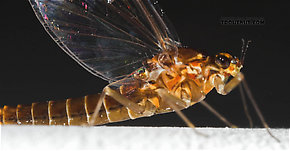 View 8 Pictures
View 8 Pictures
 View 8 Pictures
View 8 PicturesCollected May 26, 2005 from the Namekagon River in Wisconsin
Added to Troutnut.com by Troutnut on May 16, 2006
Added to Troutnut.com by Troutnut on May 16, 2006
Male Callibaetis (Speckled Spinners) Mayfly Spinner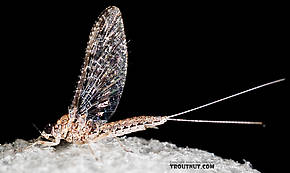 View 4 Pictures
View 4 Pictures
 View 4 Pictures
View 4 PicturesCollected August 11, 2018 from the Henry's Fork of the Snake River in Idaho
Added to Troutnut.com by Troutnut on June 12, 2019
Added to Troutnut.com by Troutnut on June 12, 2019
Female Ephemerella invaria (Sulphur Dun) Mayfly Dun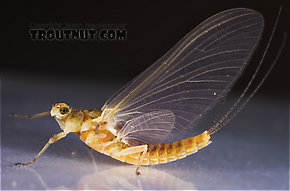 View 6 Pictures
View 6 Pictures
 View 6 Pictures
View 6 PicturesCollected May 28, 2005 from the Teal River in Wisconsin
Added to Troutnut.com by Troutnut on May 24, 2006
Added to Troutnut.com by Troutnut on May 24, 2006
Baetis bicaudatus (BWO) Mayfly Nymph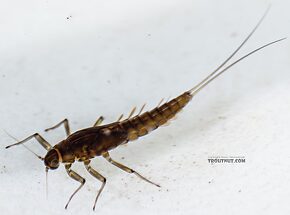 View 5 PicturesHere I'm just copying and pasting, without cleaning up, my notes from spending a long time with this one under the microscope (and keying with Merritt & Cummins 5th Ed) only to end up confirming the most likely guess.
View 5 PicturesHere I'm just copying and pasting, without cleaning up, my notes from spending a long time with this one under the microscope (and keying with Merritt & Cummins 5th Ed) only to end up confirming the most likely guess.
7. Baetis bicaudatus nymph
1. Hind wingpad present but small and hidden beneath forewing pad
2. Segment 2 of labial palp (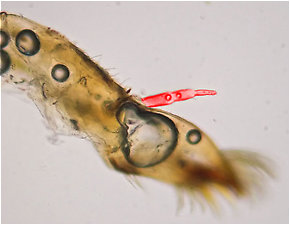 Palp: A long, thin, often segmented appendage which can protrude from certain insect mouth parts such as the maxillae. Also known as the < />palpus.) with well-developed medially projecting corner —> Baetis (couple 44)…. BUT no sign of scale-like setae (Seta: Little hairs on insects.) on abdominal terga (Tergum: the dorsal part of an abdominal segment or segments (terga). Also used to describe the entire abdominal dorsum or the thoracic dorsal segments of Odonata.). Conflicts at this couplet.
Palp: A long, thin, often segmented appendage which can protrude from certain insect mouth parts such as the maxillae. Also known as the < />palpus.) with well-developed medially projecting corner —> Baetis (couple 44)…. BUT no sign of scale-like setae (Seta: Little hairs on insects.) on abdominal terga (Tergum: the dorsal part of an abdominal segment or segments (terga). Also used to describe the entire abdominal dorsum or the thoracic dorsal segments of Odonata.). Conflicts at this couplet.
3. Gills on segments I-VII
4. Tarsal claws (Tarsal claw: The claws at the tip of the tarsus, on an insect's "foot.") with denticles (Denticle: Small tooth-like projects, often appearing like serrations on the tarsal claws of certain mayfly nymphs.), seemingly 2 rows but very hard to tell… and the key options with 2 rows don’t make sense
5. Assuming no villipore, we land confidently at couplet 48
6. Leads to Fallceon, except antennal scape doesn’t have robust setae (Seta: Little hairs on insects.)
7. Treated as Baetis, leads to brunneicolor, but McDunnough et al 1932 (Can Ent 64) suggests middle tail should be 5/6 as long as outer ones
8. Keys VERY confidently to couplet 36 in M&C (villipore)
9. If assuming villipore present:
1. 37 —> Scape of anntenae has no distal (Distal: Far from the point of attachment or origin; near the tip.) lobe —> rules out Labiobaetis (100 % certain)
2. 38 —> Terminal filament much shorter than cerci (Cercus: The left and right "tails" of an insect are known as the cerci or caudal cerci. The middle tail of a three-tailed insect is not.) —> not Barbaetis benfieldi (100 % certain)
3. 39 —> Terminal filament reduced (100 % certain)
4. 40 —> Tarsal claw (Tarsal claw: The claws at the tip of the tarsus, on an insect's "foot.") dentical count couplet. If two rows of denticles (Denticle: Small tooth-like projects, often appearing like serrations on the tarsal claws of certain mayfly nymphs.): Either Iswaeon or Heterocloeon. Can’t be Iswaeon because cerci (Cercus: The left and right "tails" of an insect are known as the cerci or caudal cerci. The middle tail of a three-tailed insect is not.) lack dark median band. Can’t be heterocloeon because it’s not in the Platte drainage or in Texas. Thus, it must be one row of denticles (Denticle: Small tooth-like projects, often appearing like serrations on the tarsal claws of certain mayfly nymphs.). Moving on to 42.
5. 42 —> Hind wing pads (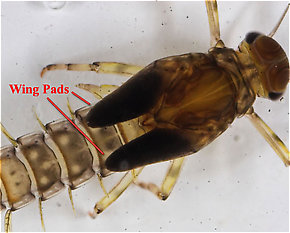 Wing pad: A protrusion from the thorax of an insect nymph which holds the developing wings. Black wing pads usually indicate that the nymph is nearly ready to emerge into an adult.) present (100 % certain)
Wing pad: A protrusion from the thorax of an insect nymph which holds the developing wings. Black wing pads usually indicate that the nymph is nearly ready to emerge into an adult.) present (100 % certain)
6. 44 —> Segment 2 of labial palpi with well-developed medially projecting corner (80 % certain), scale-like setae (Seta: Little hairs on insects.) not evident on terga (Tergum: the dorsal part of an abdominal segment or segments (terga). Also used to describe the entire abdominal dorsum or the thoracic dorsal segments of Odonata.) but maybe limitation of my scope —> Baetis (alternative would be Acentrella, but pronotum (Pronotum: The top of the insect prothorax.) shape is all wrong for those, although not an official characteristic)
7. CONFIDENT in Baetis bicaudatus after distinctive leg markings (J-shaped light mark on first femur (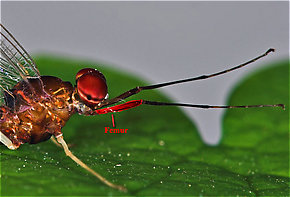 Femur: The main segment of an insect's leg close to the body, in between the tibia and the trochanter.), L-shaped on second and third) matches original species description to a tee.
Femur: The main segment of an insect's leg close to the body, in between the tibia and the trochanter.), L-shaped on second and third) matches original species description to a tee.
 View 5 PicturesHere I'm just copying and pasting, without cleaning up, my notes from spending a long time with this one under the microscope (and keying with Merritt & Cummins 5th Ed) only to end up confirming the most likely guess.
View 5 PicturesHere I'm just copying and pasting, without cleaning up, my notes from spending a long time with this one under the microscope (and keying with Merritt & Cummins 5th Ed) only to end up confirming the most likely guess.7. Baetis bicaudatus nymph
1. Hind wingpad present but small and hidden beneath forewing pad
2. Segment 2 of labial palp (

The palp on the maxilla of an Ephemerella nymph (detached and photographed under a microscope) is highlighted in red here.
3. Gills on segments I-VII
4. Tarsal claws (Tarsal claw: The claws at the tip of the tarsus, on an insect's "foot.") with denticles (Denticle: Small tooth-like projects, often appearing like serrations on the tarsal claws of certain mayfly nymphs.), seemingly 2 rows but very hard to tell… and the key options with 2 rows don’t make sense
5. Assuming no villipore, we land confidently at couplet 48
6. Leads to Fallceon, except antennal scape doesn’t have robust setae (Seta: Little hairs on insects.)
7. Treated as Baetis, leads to brunneicolor, but McDunnough et al 1932 (Can Ent 64) suggests middle tail should be 5/6 as long as outer ones
8. Keys VERY confidently to couplet 36 in M&C (villipore)
9. If assuming villipore present:
1. 37 —> Scape of anntenae has no distal (Distal: Far from the point of attachment or origin; near the tip.) lobe —> rules out Labiobaetis (100 % certain)
2. 38 —> Terminal filament much shorter than cerci (Cercus: The left and right "tails" of an insect are known as the cerci or caudal cerci. The middle tail of a three-tailed insect is not.) —> not Barbaetis benfieldi (100 % certain)
3. 39 —> Terminal filament reduced (100 % certain)
4. 40 —> Tarsal claw (Tarsal claw: The claws at the tip of the tarsus, on an insect's "foot.") dentical count couplet. If two rows of denticles (Denticle: Small tooth-like projects, often appearing like serrations on the tarsal claws of certain mayfly nymphs.): Either Iswaeon or Heterocloeon. Can’t be Iswaeon because cerci (Cercus: The left and right "tails" of an insect are known as the cerci or caudal cerci. The middle tail of a three-tailed insect is not.) lack dark median band. Can’t be heterocloeon because it’s not in the Platte drainage or in Texas. Thus, it must be one row of denticles (Denticle: Small tooth-like projects, often appearing like serrations on the tarsal claws of certain mayfly nymphs.). Moving on to 42.
5. 42 —> Hind wing pads (

The wing pads on this final instar Baetidae mayfly nymph are extremely dark.
6. 44 —> Segment 2 of labial palpi with well-developed medially projecting corner (80 % certain), scale-like setae (Seta: Little hairs on insects.) not evident on terga (Tergum: the dorsal part of an abdominal segment or segments (terga). Also used to describe the entire abdominal dorsum or the thoracic dorsal segments of Odonata.) but maybe limitation of my scope —> Baetis (alternative would be Acentrella, but pronotum (Pronotum: The top of the insect prothorax.) shape is all wrong for those, although not an official characteristic)
7. CONFIDENT in Baetis bicaudatus after distinctive leg markings (J-shaped light mark on first femur (

The femur of this Isonychia bicolor mayfly spinner is highlighted in red.
Collected August 4, 2020 from Green Lake Outlet in Idaho
Added to Troutnut.com by Troutnut on August 20, 2020
Added to Troutnut.com by Troutnut on August 20, 2020
Top 10 Fly Hatches
Top Gift Shop Designs
Eat mayflies.
Top Insect Specimens
Miscellaneous Sites
Troutnut.com is copyright © 2004-2024 Jason
Neuswanger (email Jason). See my FAQ for information about use of my images.
 privacy policy
privacy policy

